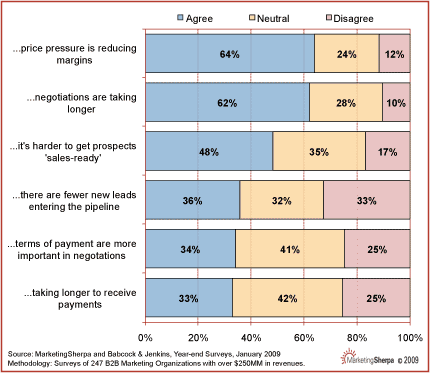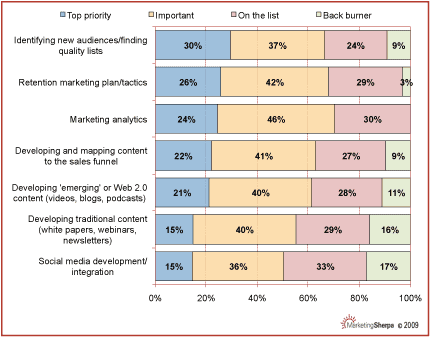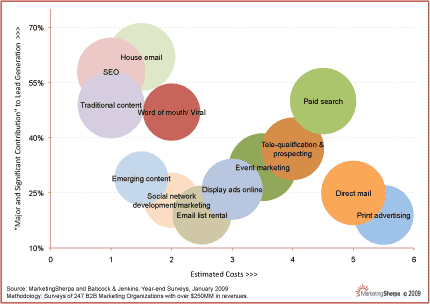The recession is for real – and so is its impact on marketers. So, Sherpa wanted to learn how marketers are positioning their 2009 lead generation efforts to deal with the hostile economic climate.
We first surveyed B2B marketers on the economy last February – when it was described as a downturn. A year later, we again surveyed marketers for B2B organizations with more than $250 million in revenue in cooperation with Babcock & Jenkins. Marketers described their top priorities and challenges for 2009, and ranked specific lead-generation tactics in their overall marketing strategy. Five data charts help to highlight the state of B2B marketing and offer tips for adapting your strategies to a recession.
Top five insights from the B2B surveyInsight #1. Longer sales cycles, reduced margins increase need for nurturing
Marketers’ have set priorities for 2009 based on conditions influencing their decisions. This chart shows how marketers described the recession’s effect on their sales and marketing processes compared to a year ago. The three biggest challenges:
- 64%: Price pressure is reducing margins.
- 62%: Negotiations are taking longer.
- 48%: Harder to get prospects “sales-ready”
With companies making less profit on each deal, marketing teams may be expected to make up the difference with more sales-ready leads – or lower their average cost per lead. At the same time, lengthy negotiations and challenges getting prospects sales-ready mean marketers must stay engaged with them longer.
Using the right mix of channels, content, offers and timing is essential to move prospects up the marketing pipeline. Marketers must focus their content- development efforts and nurturing strategies to ensure they have the right educational resources to target prospects at different stages of the buying cycle.
NOTE: There is good news in this slide. One-third of the marketers surveyed said they don’t see fewer leads entering their pipeline. That counters the 36% saying they do see fewer leads. Whichever position you’re in, the length of time you’ll need to engage those leads through nurturing programs remains a defining characteristic of this economy.
Insight #2. Retention, analytics, and finding new audiences are top priorities
For many marketers, generating leads and converting them to opportunities will be difficult. That’s why marketers have identified three top priorities for the year that will help offset a potential decline in new leads and the lengthening sales cycle.
Top Priority #1: Identifying new audiences/finding quality lists To offset a decline in leads from their in-house databases, marketers say they will work harder to expand their messaging and value proposition for new audiences. They’ll also seek additional sources of prospect names to include in campaigns and fill the top of their lead funnel.
Top Priority #2: Retention marketing plan/tactics A potential slowdown in new leads is also putting the spotlight on keeping existing customers. A company’s success will depend on retaining and upselling their past consumers, so marketers will have to increase their efforts in this area.
Top Priority #3: Marketing analyticsUsing analytics to help determine which tactics are working best and target improvements can make the most of tight marketing budgets. Analytics can also help marketers analyze exactly what customers and prospects are looking for, so they can tailor their campaign messaging and content accordingly.
Insight #3. Marketers uncertain about how to integrate Web 2.0/social media
This chart helps explain why certain goals and tactics weren’t labeled as top priorities in the previous slide. We asked marketers to rank their biggest challenges, based on lack of time or internal resources and their confidence in getting those processes right.
Top challenges:
o Social media development/integration
o Developing emerging Web 2.0 content, such as videos, blogs and podcasts
Many marketers still find Web 2.0 development a challenge. They are comparatively confident in their abilities to execute traditional campaigns and develop traditional content, such as white papers and webinars. But Web 2.0 channels and content are still relatively new to most marketers.
Integrating social media channels and content into traditional campaign activity can be an excellent way to address the need for additional nurturing. Creating blogs and podcasts, and participating in online communities can help you engage with your prospects and customers during the time between outbound marketing campaigns.
Participating in those online activities can also tie into your marketing analytics task by helping you determine the biggest challenges and questions your prospects and customers face in this environment. For example, a blog post that generates a lot of interest and chatter among readers can help you identify new subjects for a webcast or white paper.
Even though tackling these emerging channels is a challenge, consider tests of Web 2.0 and social media elements in your integrated lead generation and lead nurturing strategies.
Insight #4. “Doing more with less” tops marketers’ list of pains
We also asked marketers to rank the top pain points within their marketing department.
- Tight budgets and limited resources top the list of pain points as marketers are forced to do more with less. Larger organizations don’t expect the economy to rebound until sometime in 2010. So, marketers likely will have to operate under budget constraints beyond the end of this year.
- Generating innovative content ranked second on the list of pains. We believe this pain point reflects the challenges marketers see in creating and integrating Web 2.0 content into their marketing strategies.
- On the flip side, marketers reported little pain in keeping highly skilled staff members, such as SEO experts. This contrasts with previous years, when marketers said they had trouble retaining those highly skilled employees. SEO, in particular, is an area where an individual often leaves a job to become an independent consultant, or is cherry-picked by competition when they can demonstrate their skill.
Are you a marketer in the enviable position of adding staff this year? You might find it easier to attract those talented personnel who have lost jobs at other companies, or are looking for the security of a staff position over a consulting role.
Insight #5. Focus on low-cost, high-return tactics, but don’t overlook the basics. 
This bubble chart compares the reported effectiveness of specific lead generation tactics with their estimated cost per lead. The 'Y' axis shows the percentage of marketers who said a tactic makes a major and significant contribution to lead generation. The 'X' axis displays the estimated cost per lead of each tactic. The size of each bubble represents the percentage of marketers who engage in each tactic.
Pay close attention to the cluster of bubbles in the upper left portion of the chart. Most marketers cite these tactics as major contributors of leads with some of the lowest estimated costs per lead:
o House email
o SEO
o Traditional content
o Word-of-mouth/viral marketing
On the other hand, these rankings are based on marketers’ past activities. The four tactics cited above represent what has worked well for marketers in the past. Except for word-of-mouth/viral marketing, they are classic tactics familiar to most marketers.
In the coming year, we expect to see newer tactics, such as emerging content and social network development/marketing, to make a larger contribution to lead generation efforts. Sales cycles are expanding and prospects are becoming more wary of traditional marketing messages. So, well-timed, relevant contributions to social networks and Web 2.0 channels can keep prospects engaged with your brand and show that you understand prospects’ needs and interests.
Also, don’t write off high-cost tactics that appear to make a relatively low contribution to lead generation. Tactics, such as direct mail and telemarketing, are essential pieces of a well-rounded lead nurturing campaign. Some prospects may respond more favorably to these higher-touch outreach efforts, and lead nurturing is all about connecting with the right prospect at the right time and in the right way.
Likewise, don’t entirely discount print advertising’s role. Print campaigns tend to focus on branding, so it’s not surprising that ads alone don’t directly constitute a major source of leads. Branding campaigns, however, can create higher awareness that improves the effectiveness and trustworthiness of your lead gen efforts.
With budgets under scrutiny, many marketers are choosing to cut back on advertising spending. As a result, brand impressions may be cheaper to acquire than in previous years. So, consider whether a well-designed, well-placed branding campaign can play a cost-effective supporting role for your 2009 lead generation efforts.
Useful links related to this article: Babcock & Jenkins
http://bnj.com/














